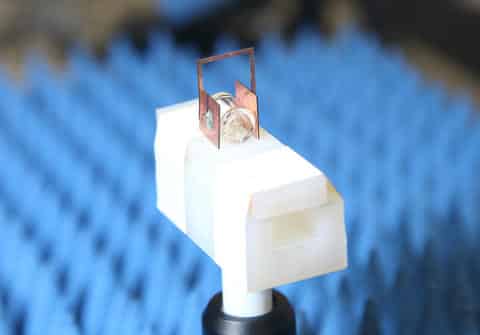The National Institute of Standards and Technology (NIST) has improved the sensitivity of their atomic radio receiver by putting the small glass cylinder containing cesium atoms inside what appear to be special copper “headphones.”

The structure, which consists of a square overhead loop connecting two square panels, boosts the incoming radio signal, or electric field, that is applied to the gaseous atoms in the flask (also known as a vapour cell) between the panels. The radio receiver can now identify much weaker signals than previously. The headphone structure is a split-ring resonator, which functions like a metamaterial – a material with new structures that produces strange properties. “We can call it a metamaterials-inspired structure,” NIST project leader Chris Holloway said.
The NIST radio receiver is based on a unique atomic state. Researchers employ two different colour lasers to convert atoms in the vapour cell into high-energy (“Rydberg”) states, which have unique traits like extraordinary sensitivity to electromagnetic fields. The colours of light absorbed by the atoms are affected by the frequency and strength of an applied electric field, which has the effect of transforming the signal strength to an optical frequency that can be measured reliably.
A radio signal supplied to the new resonator causes currents to flow through the overhead loop, resulting in a magnetic flux, or voltage. The copper structure’s dimensions are less than the wavelength of the radio transmission. As a result, the small physical gap between the metal plates has the potential to cause problems. “The loop captures the incoming magnetic field, creating a voltage across the gaps,” Holloway said. “Since the gap separation is small, a large electromagnetic field is developed across the gap.”
Atom-based receivers may offer many advantages over traditional radio technology with future development. The atoms, for example, operate as an antenna, and typical electronics aren’t required to transform signals to other frequencies for delivery because the atoms do it automatically. Atom receivers can be physically smaller, with dimensions on the micrometre scale. Furthermore, some types of interference and noise may be less sensitive to atom-based systems.
Click here to read their research.





